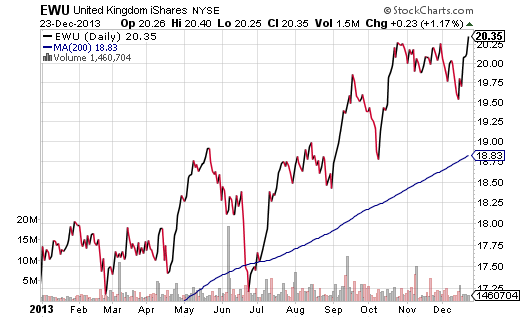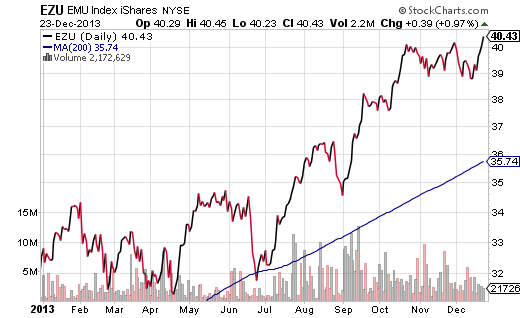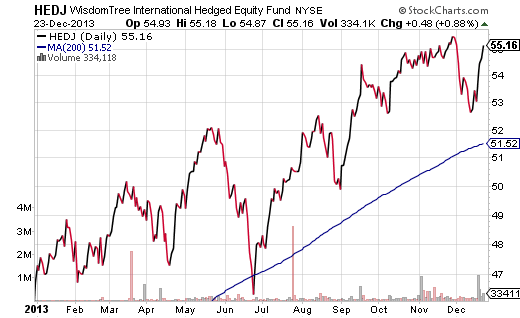Some media writers have expressed little surprise by the extent of the run-up in U.S. stocks. It’s one thing to be bullish. It’s quite another to look at 28% year-to-date gains for the S&P 500 as customary.
Super-sized annual percentage jumps occur more frequently in the initial year of a bull market. That’s why one can look upon the 38% in 1975, 26% in 1991, the 26% in 2003 and/or the 23% in 2009 as commonplace. Yet a 28% rise in the fifth calendar year of a stock bull? One would have to regard the move as having more in common with the irrational exuberance of the latter half of the 1990s.
That’s not to say that the monster move to the upside here in 2013 is entirely without reason. The U.S. Federal Reserve has given global investors plenty of ammunition for remaining long U.S. stocks. Nevertheless, the premier opportunities going forward may reside with risk assets that are not only trending higher, but also have additional advantages.
Here are three justifications for shifting some cash and/or U.S. stock dollars over to foreign stock ETFs:
1. Value. U.S. corporate earnings have been slowing in recent quarters. Sales have been flat. Meanwhile, share prices have soared through the proverbial roof.
On the flip side, corporate earnings in places like the United Kingdom are rocketing. An investor can tap UK potential with the iShares United Kingdom ETF (EWU). A series of “higher highs” for EWU has essentially confirmed a strong uptrend since July.
The concept of valuation vis-a-vis corporate profits also favors foreign developed equities. On forward estimates of earnings, the Stoxx Europe 600 Index chimes in with a P/E ratio of 13.7; Factset tags the S&P 500 with an optimistic 15.1 based on estimates for the next 12 months of earnings. For those who place more value on trailing 12 months profits, SPDR EuroStoxx 50 (FEZ) currently shows a P/E of roughly 14; Biryini Associates pegs the trailing 12 month P/E estimate at a lofty 18.5. In sum, foreign developed stocks might be trading at a discount of anywhere from 10%-30%.
2. Trading Volume
A funny thing happened on the way to the European credit crisis. Specifically, investors appear to accept the monetary union’s commitment to the euro. In turn, more folks are venturing back into European equities. According to data provided by Merrill Lynch, stock mutual funds and exchange-traded funds dedicated to Europe just set a record with 20 consecutive weeks of inflow. The enormous amount of cash pouring into these funds forces money managers to increase their buying activity.
The increase in trading volume is not only evident in the inflow data, but by the shares that European exchanges have reported as well. The current estimate for 2013 is that trading volume for European equities rose by roughly 20% year-over-year. Moreover, record levels of trading are being registered by institutional investors in “dark pools” — venues that do not display prices so that participants can place orders anonymously.
What does it all add up to? Institutional and retail investors are rediscovering an appetite for European stocks. ETF enthusiasts may want to investigate the technically strong uptrends in regional stalwarts like the iShares S&P Europe 350 ETF (IEV) and the iShares MSCI European Monetary Union ETF (EZU).
3. Economic Stimulus
The Federal Reserve may delay a tapering increment and “talk up” current levels of monetary policy accommodation, but it is unlikely to reverse course by increasing the monthly money printing. Meanwhile, the U.S. Congress has no appetite for passing any form of fiscal stimulus in 2014. In brief, the U.S. economy is closer to having to sink or swim on its own.
In contrast, the European Central Bank (ECB) is in an earlier stage of providing stimulus and recently cut its benchmark lending rate. The ECB may even emboldened by the perceived success of the Fed’s zero-interest-rate policy. Considering the extent of the remarkable rallies in U.S. and Japanese stocks — taking into account that the bulk of the gains are primarily attributable to monetary stimulus efforts — foreign developed stocks in Europe and Asia may be in the 2014 the driver’s seat.
By the same token, both the euro and the yen should feel the dollar’s heat, especially if the U.S. stays on its tapering course at the same time that Japan and Europe ratchet up their easing. ETF investors would benefit by hedging their currency exposure with the WisdomTree Hedged Europe Fund (HEDJ), the WisdomTree Hedged Germany ETF (DXGE) or the Wisdom Tree Hedged Japan Equity fund (DXJ). 
Disclosure: Gary Gordon, MS, CFP is the president of Pacific Park Financial, Inc., a Registered Investment Adviser with the SEC. Gary Gordon, Pacific Park Financial, Inc, and/or its clients may hold positions in the ETFs, mutual funds, and/or any investment asset mentioned above. The commentary does not constitute individualized investment advice. The opinions offered herein are not personalized recommendations to buy, sell or hold securities. At times, issuers of exchange-traded products compensate Pacific Park Financial, Inc. or its subsidiaries for advertising at the ETF Expert web site. ETF Expert content is created independently of any advertising relationships.
- English (UK)
- English (India)
- English (Canada)
- English (Australia)
- English (South Africa)
- English (Philippines)
- English (Nigeria)
- Deutsch
- Español (España)
- Español (México)
- Français
- Italiano
- Nederlands
- Português (Portugal)
- Polski
- Português (Brasil)
- Русский
- Türkçe
- العربية
- Ελληνικά
- Svenska
- Suomi
- עברית
- 日本語
- 한국어
- 简体中文
- 繁體中文
- Bahasa Indonesia
- Bahasa Melayu
- ไทย
- Tiếng Việt
- हिंदी
3 Reasons Foreign Stock ETFs Can Outperform U.S. Stock ETFs
Published 12/23/2013, 11:44 PM
Updated 03/09/2019, 08:30 AM
3 Reasons Foreign Stock ETFs Can Outperform U.S. Stock ETFs
Latest comments
Loading next article…
Install Our App
Risk Disclosure: Trading in financial instruments and/or cryptocurrencies involves high risks including the risk of losing some, or all, of your investment amount, and may not be suitable for all investors. Prices of cryptocurrencies are extremely volatile and may be affected by external factors such as financial, regulatory or political events. Trading on margin increases the financial risks.
Before deciding to trade in financial instrument or cryptocurrencies you should be fully informed of the risks and costs associated with trading the financial markets, carefully consider your investment objectives, level of experience, and risk appetite, and seek professional advice where needed.
Fusion Media would like to remind you that the data contained in this website is not necessarily real-time nor accurate. The data and prices on the website are not necessarily provided by any market or exchange, but may be provided by market makers, and so prices may not be accurate and may differ from the actual price at any given market, meaning prices are indicative and not appropriate for trading purposes. Fusion Media and any provider of the data contained in this website will not accept liability for any loss or damage as a result of your trading, or your reliance on the information contained within this website.
It is prohibited to use, store, reproduce, display, modify, transmit or distribute the data contained in this website without the explicit prior written permission of Fusion Media and/or the data provider. All intellectual property rights are reserved by the providers and/or the exchange providing the data contained in this website.
Fusion Media may be compensated by the advertisers that appear on the website, based on your interaction with the advertisements or advertisers.
Before deciding to trade in financial instrument or cryptocurrencies you should be fully informed of the risks and costs associated with trading the financial markets, carefully consider your investment objectives, level of experience, and risk appetite, and seek professional advice where needed.
Fusion Media would like to remind you that the data contained in this website is not necessarily real-time nor accurate. The data and prices on the website are not necessarily provided by any market or exchange, but may be provided by market makers, and so prices may not be accurate and may differ from the actual price at any given market, meaning prices are indicative and not appropriate for trading purposes. Fusion Media and any provider of the data contained in this website will not accept liability for any loss or damage as a result of your trading, or your reliance on the information contained within this website.
It is prohibited to use, store, reproduce, display, modify, transmit or distribute the data contained in this website without the explicit prior written permission of Fusion Media and/or the data provider. All intellectual property rights are reserved by the providers and/or the exchange providing the data contained in this website.
Fusion Media may be compensated by the advertisers that appear on the website, based on your interaction with the advertisements or advertisers.
© 2007-2025 - Fusion Media Limited. All Rights Reserved.
